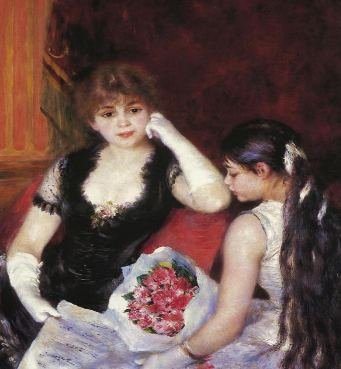Renoir at the Theatre
dal 20/2/2008 al 24/5/2008
Segnalato da
20/2/2008
Renoir at the Theatre
The Courtauld Institute of Art, London
Concentrating on the early years of Impressionism during the 1870s, the exhibition explores how these artists used the loge to capture the excitement and changing nature of fashionable Parisian society. The interest in the theatre, and particularly the loge as a space for social display, was also harnessed by the booming fashion industry which catered to the aspirational and newly wealthy middle class.

Pierre-Auguste Renoir’s La Loge (The Theatre Box), 1874, is one of the masterpieces of Impressionism and a major highlight of The Courtauld Gallery’s collection. Its depiction of an elegant couple on display in a loge, or box at the theatre, epitomises the Impressionists’ interest in the spectacle of modern life. In celebration of The Courtauld Institute of Art’s 75th anniversary the exhibition Renoir at the Theatre: Looking at ‘La Loge’, on view from 21 February to 25 May 2008, unites La Loge for the first time with Renoir’s other treatments of the subject and loge paintings by contemporaries, including Mary Cassatt and Edgar Degas. Concentrating on the early years of Impressionism during the 1870s, the exhibition explores how these artists used the loge to capture the excitement and changing nature of fashionable Parisian society.
La Loge (fig. 1) was Renoir’s principal exhibit in the first Impressionist exhibition in Paris in 1874. The complexity of its subject matter and its virtuoso technique helped to establish the artist’s reputation as one of the leaders of this radical new movement in French art. Renoir’s brother Edmond and Nini Lopez, a model from Montmartre known as ‘Fish-face’, posed for this ambitious composition. At the heart of the painting is the complex play of gazes enacted by these two figures seated in a theatre box. The elegantly dressed woman lowers her opera glasses, revealing herself to admirers in the theatre, whilst her male companion trains his gaze elsewhere in the audience. In turning away from the performance, Renoir focused instead upon the theatre as a social stage where status and relationships were on public display.
Theatre in Paris was a rapidly expanding industry during the 19th century, dominating the cultural life of the city. At the time of La Loge it was estimated that over 200,000 theatre tickets were sold every week in Paris. Theatres ranged from the popular variety act venues to the fashionable elegance of the great opera houses. The burgeoning wealth of the middle classes meant that the loges of the premier theatres were no longer the preserve of high society. From the 1830s onwards celebrated caricaturists such as Honoré Daumier (1808-79) and Paul Gavarni (1804-66) seized upon the theatre box as a rich theme for social satire.
By the 1870s leering men with over-sized opera glasses, middle-aged women struggling to maintain their appeal, fathers parading their elegant daughters, and gauche visitors from the provinces had emerged as stock types in weekly magazines such as Le Petit Journal pour Rire (fig. 9). The interest in the theatre, and particularly the loge as a space for social display, was also harnessed by the booming fashion industry which catered to the aspirational and newly wealthy middle class. Lavishly produced journals such as La Mode Illustrée included fine hand-coloured engravings showing the latest fashions modelled by elegant ladies in theatre boxes (fig. 8). A rich selection of this little-known graphic material from contemporary Parisian journals will be on display in the exhibition.
Image: Pierre-Auguste Renoir (1841-1919) - At the Concert, 1880, oil on canvas, 99 x 80 cm
The Sterling and Francine Clark Art Institute, Williamstown
Katie Rix
Sue Bond Public Relations
T: +44 (0) 1359 271085 F: +44 (0) 1359 271934
http://www.suebond.co.uk/
Courtauld Institute
Somerset House - Strand, London



